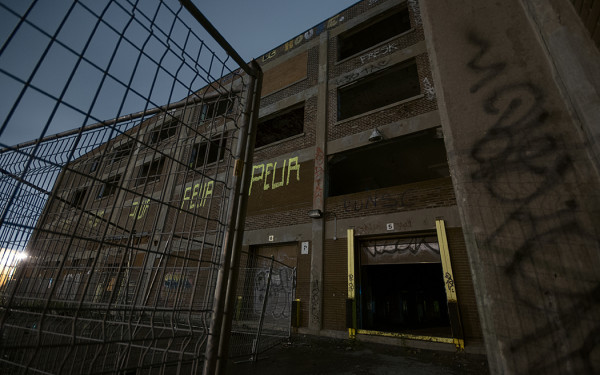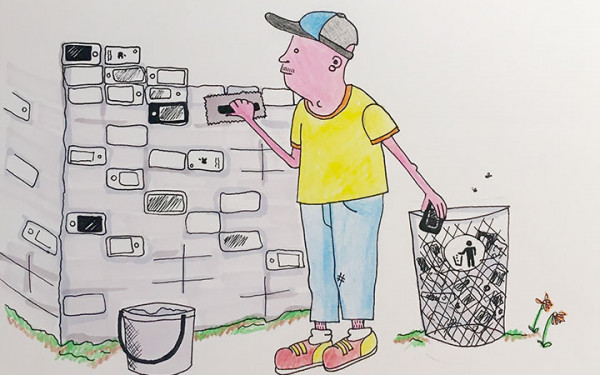Concordia’s Institute for Urban Futures Introduces First Futurists-in-Residence
The New Institute Will Explore Urban Sustainability, Architecture, Art and Culture
The old hospitals that the new McGill University Health Centre slurped into its gravitational pull left behind over 210,000 square metres of floor space, or roughly five Olympic Stadiums.
Now vacant, those buildings still stand.
Hospitals are far from the only “dead spaces” in Montreal. The former Dow Planetarium on St. Jacques St. W. is but a shell. The red brick Cadieux Forge on St. Paul St. W., a testament to Montreal’s booming industrial past, now hulks uselessly over the sidewalk.
Concordia’s Institute for Urban Futures has united with Entremise, a non-profit organization seeking to match space-less people to people-less spaces, to address this scourge. The partnership was celebrated on Thursday, at the Institute’s 2016 program launch, where the non-profit’s co-founders Jonathan Lapalme and Mallory Wilson became the Institute’s first official “Urban Futurists in Residence.”
A futurist is one who studies the future while making predictions based o of current trends. Urban futurists “think long-term about the future more rigorously,” Dr. Cindy Frewen, current Chair of the Association of Professional Futurists, told the GB Times in January 2015. As social scientists, they act as authorities, predicting proposal-outcomes and analyzing risk. Th e whole point of urban futurism is to make better decisions today, according to Dr. Frewen.
The Concordia Institute, which is under the university’s Centre for Interdisciplinary Studies in Society and Culture, will be a space for graduate students to work with futurists, artists, faculty and researchers to explore urban issues.
The launch took place at Temps Libre Mile End on De Gaspé Ave, a new community workspace that Concordia is a founding partner of. Back in the happening 1960’s, the street served as Montreal’s garment district, harbouring stockrooms full of bolts of fabric and furry pelts. The industry’s move to Chabanel St. W. in Ahuntsic-Cartierville left behind many deserted warehouses.
“Vacancy is a problem,” Lapalme said during the night’s presentation. “It represents, for example, the highest risk of fire.”
The abandoned Our Lady of Fatima Church in Longueuil burned down in September. e Des Carrières St. incinerator, whose twin chimneys tower inactive over Rosemont, caught re in March of 2015.
Lapalme and Wilson insisted the best way to put people in these buildings is through “temporary use.”
The strategy seeks to find short-term, low-paying tenants for vacant spaces, until something can be permanently nailed down. As one attendee put it in the question period after, “It’s like freelancing, but for buildings.”
“There’s a quest for permanence. All classical architecture and design mandates it and temporary use flies in its face.” – Mallory Wilson, Entremise co-founder
“Entremise comes in and acts like a broker between vacant structures, owners with no will to use them, and parties who want to move in for an indeterminate amount of time,” Lapalme said from behind a laptop in the back of the room.
Entremise’s beneficiaries—mostly start-ups, artist collectives and live-in renters—treat the building better than the ravages of vacancy, the co-founders said. Plus, repurposing alle- viates environmental burden of clearing the spaces and building anew, they continued.
Lapalme explained that replacing an old building with 30 per cent more energy e – cient requires such initial consumption that it would take about 80 post-construction years to break even in its use of energy materials.
Still, property owners don’t want to adopt the strategy. “They see it as a failure,” Wilson explained.
“There’s a quest for permanence,” Wilson said in an interview after the presentation.“All classical architecture and design mandates it and temporary use flies in its face.”
She referred to the Vitruvian Triad, Vitruvius’s pre-Christian architectural principles of solidity, utility and beauty.
“Oftentimes developers, city planners and authorities will feel that they failed in their part if they can’t accomplish permanence,” she said.
Wilson brought up the St. Sulpice Library, the neoclassical neighbour to the bar by the same name on St. Denis St. It has been empty for over a decade.
“Every time someone came up with a use for it, heritage conservation people and city people would ask: ‘But is it the use?’” she said. “Over time, it kept degrading.”
Now that a use has nally been determined—the library will reopen its doors in 2017 as an educational space and an incubation laboratory for young people, according to Culture Montreal General Director Valérie Beaulieu—the edifice requires a $17 million provincial subsidy.
During their presentation, Lapalme and Wilson told a similar story about the former American embassy in Ottawa. The building opposite Parliament has been empty for 20 years, except a brief initiative to convert it into a portrait gallery. Waiting for the “great idea,” according to Lapalme, costs taxpayers $200,000 every year in maintenance.
“If you have a beautiful building that’s all Beaux-Arts and gilded and I tell you a bunch of squatters are going to come live in it, the reaction is quite visceral, right?” Wilson said, trying to make sense of resistance to the initiative.
But squatters—as opposed to scrappers who ravage the building for materials, as pointed out by a woman in the crowd—do take care of the building, Lapalme said, o set- ting eventual demolition or renovation costs.
They are living in the place, after all.

web_900_600_90.jpg)
_900_596_90.jpg)
_600_832_s.png)




